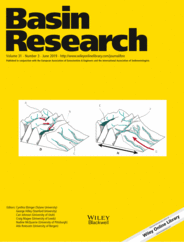
Full text loading...
 , Bruno Campo1, Andrea Di Martino1, Wan Hong2, Alessandro Amorosi1
, Bruno Campo1, Andrea Di Martino1, Wan Hong2, Alessandro Amorosi1
Peat horizons are characteristic features of delta plains worldwide. In this study, we tested the use of peat‐based correlations to assess the deformation of Holocene strata in the Po coastal plain (Northern Italy). The Holocene stratigraphy, about 30 km inland from the modern coastline consists of a peat‐bearing, estuarine and deltaic succession, up to 23 m thick. Through the analysis of 31 core data and 100 piezocone penetration tests, we identified and mapped three 10–40 cm‐thick peat layers (T1–T3) dated to 6.6–5.8, 5.5–5.0 and 3.3–2.7 cal kyr BP respectively. These peat horizons were found to be suitable stratigraphic markers within the Holocene succession over an area of about 200 km2. The mid‐late Holocene palaeogeography, reconstructed through high‐resolution peat correlation, supported by 72 radiocarbon dates, highlights a typical upper delta plain environment, with ribbon‐shaped distributary channels and swamp interdistributary areas. Peat layers are inclined towards E‐NE with gradients that increase downsection from ~0.016% (T3) to 0.021% (T1). The gradient of the oldest peat horizon is one order of magnitude larger than the slope of the modern delta plain (~0.0025%). We infer that peat horizons accumulated during periods of low sediment supply mainly controlled by autogenic processes and were deformed after deposition. Differential compaction of underlying sedimentary strata and recent tectonic activity of the buried Apenninic thrust systems are the most likely drivers of strata deformation. Based on isochore maps, we document that higher sedimentation rates in topographically depressed areas compensated, in part at least, the ongoing deformation, keeping unaltered the topographic gradient and the depositional environment. This study demonstrates that peat‐based correlation and mapping can shed lights on the mechanisms of strata accumulation and deformation in deltaic settings, constituting a robust basis for reconstructing delta evolution.

Article metrics loading...

Full text loading...
References


Data & Media loading...

